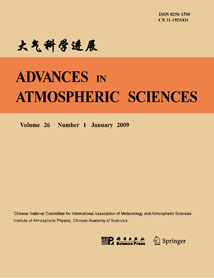| [1] |
Sijia LI, Yuan WANG, Huiling YUAN, Jinjie SONG, Xin XU,
2016: Ensemble Mean Forecast Skill and Applications with the T213 Ensemble Prediction System, ADVANCES IN ATMOSPHERIC SCIENCES, 33, 1297-1305.
doi: 10.1007/s00376-016-6155-2
|
| [2] |
Jun Kyung KAY, Hyun Mee KIM, Young-Youn PARK, Joohyung SON,
2013: Effect of Doubling the Ensemble Size on the Performance of Ensemble Prediction in the Warm Season Using MOGREPS Implemented at the KMA, ADVANCES IN ATMOSPHERIC SCIENCES, 30, 1287-1302.
doi: 10.1007/s00376-012-2083-y
|
| [3] |
TAN Jiqing, XIE Zhenghui, JI Liren,
2003: A New Way to Predict Forecast Skill, ADVANCES IN ATMOSPHERIC SCIENCES, 20, 837-841.
doi: 10.1007/BF02915409
|
| [4] |
Zheng HE, Pangchi HSU, Xiangwen LIU, Tongwen WU, Yingxia GAO,
2019: Factors Limiting the Forecast Skill of the Boreal Summer Intraseasonal Oscillation in a Subseasonal-to-Seasonal Model, ADVANCES IN ATMOSPHERIC SCIENCES, 36, 104-118.
doi: 10.1007/s00376-018-7242-3
|
| [5] |
Xiaogu ZHENG,
2009: An Adaptive Estimation of Forecast Error Covariance Parameters for Kalman Filtering Data Assimilation, ADVANCES IN ATMOSPHERIC SCIENCES, 26, 154-160.
doi: 10.1007/s00376-009-0154-5
|
| [6] |
Qian ZOU, Quanjia ZHONG, Jiangyu MAO, Ruiqiang DING, Deyu LU, Jianping LI, Xuan LI,
2023: Impact of Perturbation Schemes on the Ensemble Prediction in a Coupled Lorenz Model, ADVANCES IN ATMOSPHERIC SCIENCES, 40, 501-513.
doi: 10.1007/s00376-022-1376-z
|
| [7] |
Zhizhen XU, Jing CHEN, Zheng JIN, Hongqi LI, Fajing CHEN,
2020: Representing Model Uncertainty by Multi-Stochastic Physics Approaches in the GRAPES Ensemble, ADVANCES IN ATMOSPHERIC SCIENCES, 37, 328-346.
doi: 10.1007/s00376-020-9171-1
|
| [8] |
Jing Ma, Haiming Xu, Changming Dong, Jingjia Luo,
2023: Forecast Skills and Predictability Source of the Marine Heatwaves in the NUIST-CFS1.0 Hindcasts, ADVANCES IN ATMOSPHERIC SCIENCES.
doi: 10.1007/s00376-023-3139-x
|
| [9] |
Temesgen Gebremariam ASFAW, Jing-Jia LUO,
2022: Seasonal Prediction of Summer Precipitation over East Africa Using NUIST-CFS1.0, ADVANCES IN ATMOSPHERIC SCIENCES, 39, 355-372.
doi: 10.1007/s00376-021-1180-1
|
| [10] |
Gill M. MARTIN, Nick J. DUNSTONE, Adam A. SCAIFE, Philip E. BETT,
2020: Predicting June Mean Rainfall in the Middle/Lower Yangtze River Basin, ADVANCES IN ATMOSPHERIC SCIENCES, 37, 29-41.
doi: 10.1007/s00376-019-9051-8
|
| [11] |
Jing WANG, Bin WANG, Juanjuan LIU, Yongzhu LIU, Jing CHEN, Zhenhua HUO,
2020: Application and Characteristic Analysis of the Moist Singular Vector in GRAPES-GEPS, ADVANCES IN ATMOSPHERIC SCIENCES, 37, 1164-1178.
doi: 10.1007/s00376-020-0092-9
|
| [12] |
LIU Xiangwen, WU Tongwen, YANG Song, JIE Weihua, NIE Suping, LI Qiaoping, CHENG Yanjie, LIANG Xiaoyun,
2015: Performance of the Seasonal Forecasting of the Asian Summer Monsoon by BCC_CSM1.1(m), ADVANCES IN ATMOSPHERIC SCIENCES, 32, 1156-1172.
doi: 10.1007/s00376-015-4194-8
|
| [13] |
Chen Jiabin, A.J. Simmons,
1990: Sensitivity of Medium-Range Weather Forecasts to the Use of Reference Atmosphere, ADVANCES IN ATMOSPHERIC SCIENCES, 7, 275-293.
doi: 10.1007/BF03179761
|
| [14] |
Qiu Yongyan, Zhu Yafen,
1987: MEDIUM-RANGE OSCILLATIONS OF SYNOPTIC SYSTEMS IN SUMMER, ADVANCES IN ATMOSPHERIC SCIENCES, 4, 395-402.
doi: 10.1007/BF02656740
|
| [15] |
Masoud NOBAKHT, Bahram SAGHAFIAN, Saleh AMINYAVARI,
2021: Skill Assessment of Copernicus Climate Change Service Seasonal Ensemble Precipitation Forecasts over Iran, ADVANCES IN ATMOSPHERIC SCIENCES, 38, 504-521.
doi: 10.1007/s00376-020-0025-7
|
| [16] |
Lu Jingxi, Ding Yihui,
1989: Medium-Range Oscillations in the Summer Tropical Easterlies at 200 hPa, ADVANCES IN ATMOSPHERIC SCIENCES, 6, 301-312.
doi: 10.1007/BF02661536
|
| [17] |
Jiangshan ZHU, Fanyou KONG, Xiao-Ming HU, Yan GUO, Lingkun RAN, Hengchi LEI,
2018: Impact of Soil Moisture Uncertainty on Summertime Short-range Ensemble Forecasts, ADVANCES IN ATMOSPHERIC SCIENCES, 35, 839-852.
doi: 10.1007/s00376-017-7107-1
|
| [18] |
Swati Basu, K. J. Ramesh, Z. N. Begum,
1999: Medium Range Prediction of Summer Monsoon Activities over India vis-a-vis Their Correspondence with the Observational Features, ADVANCES IN ATMOSPHERIC SCIENCES, 16, 133-146.
doi: 10.1007/s00376-999-0009-0
|
| [19] |
Chen Longxun, Jin Zuhui,
1984: THE MEDIUM-RANGE VARIATIONS OF THE SUMMER MONSOON CIRCULATION SYSTEM OVER EAST ASIA, ADVANCES IN ATMOSPHERIC SCIENCES, 1, 224-245.
doi: 10.1007/BF02678135
|
| [20] |
Lu Longhua, Chen Xianji, Zhu Fukang,
1985: THE INTERANNUAL VARIATION OF MEDIUM-RANGE OSCILLATION CHARACTERISTICS IN THE UPPER TROPOSPHERE OVER THE SUBTROPICAL REGION, ADVANCES IN ATMOSPHERIC SCIENCES, 2, 54-62.
doi: 10.1007/BF03179737
|















 AAS Website
AAS Website 
 AAS WeChat
AAS WeChat 
 DownLoad:
DownLoad: